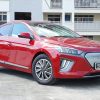Changes To COE From May 2022: Here’s What To Know
In March, the Land Transport Authority (LTA) introduced revisions to its current COE categories, making certain electric vehicles (EVs) more affordable.
Why, you might ask? The move is a part of LTA’s initiative to cut down Singapore’s emissions by a significant level of 80%. By introducing these revisions, it’s expected that EVs will become a more attainable option to those interested in owning an EV.

Looking At Existing Categories
We break down the current classification in the table below, straight from LTA.
| Category A | Car with engine capacity up to 1,600cc and Maximum Power Output of up to 97kw (130bhp) |
| Category B | Car with engine capacity above 1,600cc or MPO above 97kw (130bhp) |
A raise in the maximum power output of said vehicles is expected, from the options available for potential motorists. Currently, Category A COEs only apply to cars with an engine capacity of up to 1,600cc and a MPO of 97kw or 130 brake horsepower (bhp).
Aside to changes in the classification, premiums are also seeing a rise in this cycle, with an increase of around 4%.
Changes to Category A vehicles
From 1 May 2022, the classification will change as seen below:
| Category A | Car, except fully electric car, with engine capacity up to 1,600cc and Maximum Power Output up to 97kW (130bhp);
and fully electric car with Maximum Power Output up to 110kW (147bhp) |
| Category B | Car, except fully electric car, with engine capacity above 1,600cc or Maximum Power Output above 97kW (130bhp);
and fully electric car with Maximum Power Output above 110kW (147bhp) |

This change means that EVs with an output less than 110kW (147bhp) will become reclassified from Category B to Category A, leading to a significant reduction in prices for these vehicles.
Furthermore, with the introduction of this new categorisation, more EVs will come under Category A, such as:
- Hyundai Ioniq Electric
- Kona Electric
- Kia Niro Electric Short Range
- Nissan Leaf

Why Now?
Following 2013, the basis for the criterion of 97kw suggested a market shift, where smaller luxury petrol cars with turbocharged engines were recategorised into Category B.
Last year, Transport Minister S. Iswaran also shared, “mass-market electric cars in international markets tend to have a MPO of 110kW or lower. Locally, more mass-market electric vehicle models with a MPO above 97kW have been introduced in the last year,”.
While currently a majority of EV users also live in private housing, there is a strong shift in the tide coming. It is expected that more charging points will be available in car parks in time in order to meet this expected demand. With the HDB pledging to install points in around 2,000 Housing Board complex in the coming years.
Apart from this, LTA also has a target of installing 60,000 charging points island wide before 2030 is up.
Moving To EVs
Following years of debate surrounding making EVs more accessible to the masses in Singapore, the time is finally here.
With a major benefit of reducing carbon dioxide emissions, EVs seem to be a clear choice going forward when it comes to Singapore achieving its sustainability goals as a part of The Singapore Green Plan. As a part of this plan, Singapore aims to achieve 100% cleaner energy vehicles in the next two decades.
How do you feel about the new classification? Share your thoughts with us on Facebook!










